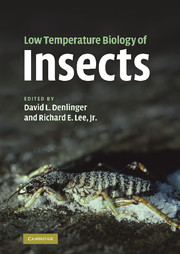Book contents
- Frontmatter
- Contents
- List of contributors
- Preface
- PART I PHYSIOLOGICAL AND MOLECULAR RESPONSES
- PART II ECOLOGICAL AND EVOLUTIONARY RESPONSES
- 8 The macrophysiology of insect cold-hardiness
- 9 Evolutionary physiology of insect thermal adaptation to cold environments
- 10 Insects at not so low temperature: Climate change in the temperate zone and its biotic consequences
- 11 Genetic variability and evolution of cold-tolerance
- 12 Life-history adaptations to polar and alpine environments
- PART III PRACTICAL APPLICATIONS
- Index
- References
8 - The macrophysiology of insect cold-hardiness
from PART II - ECOLOGICAL AND EVOLUTIONARY RESPONSES
Published online by Cambridge University Press: 04 May 2010
- Frontmatter
- Contents
- List of contributors
- Preface
- PART I PHYSIOLOGICAL AND MOLECULAR RESPONSES
- PART II ECOLOGICAL AND EVOLUTIONARY RESPONSES
- 8 The macrophysiology of insect cold-hardiness
- 9 Evolutionary physiology of insect thermal adaptation to cold environments
- 10 Insects at not so low temperature: Climate change in the temperate zone and its biotic consequences
- 11 Genetic variability and evolution of cold-tolerance
- 12 Life-history adaptations to polar and alpine environments
- PART III PRACTICAL APPLICATIONS
- Index
- References
Summary
Introduction: macrophysiology
During the early part of the twentieth century, comparative physiological studies were as much at home in ecological journals as they were in those devoted to physiology. Indeed, Shelford (1913) considered ecology to be a “branch of general physiology which deals with the organism as a whole…and which also considers the organism with particular reference to its usual environment”. For reasons that have been discussed elsewhere (e.g. Huey, 1991; Spicer and Gaston, 1999; Chown et al., 2004) ecology and physiology subsequently parted ways with both increasing their focus on smaller-scale questions. Although large-scale ecological and biogeographic work continued, interest in physiological mechanisms waned (see e.g. Myers and Giller, 1988; Lomolino and Heaney, 2004). In much the same way, large-scale comparative physiological ecology dwindled in significance, making studies such as those by Scholander et al. (1953) and Brattstrom (1968) milestones along an increasingly deserted road. Clearly, investigations of animal responses to the environment continued (the work of Bartholomew stands out especially (Dawson, 2005) (see also reviews in Prosser, 1986; Angilletta et al., 2002; Hoffmann et al., 2003), and the development of methods to correct for phylogenetic non-independence prompted a resurgence of interest in understanding the evolution of physiological traits and their variation among species and higher taxa (Feder et al., 2000). However, by the late 1980s, the subject of organismal physiological diversity was in several ways thought to be a dead end.
- Type
- Chapter
- Information
- Low Temperature Biology of Insects , pp. 191 - 222Publisher: Cambridge University PressPrint publication year: 2010
References
- 10
- Cited by

